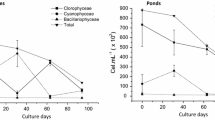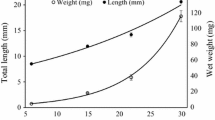Abstract
The effect of different dietary concentrations of shrimp protein hydrolysate (SPH) on digestive enzyme activity of Nile tilapia juveniles was evaluated. SPH concentrations in diets were 0, 15, 30 and 60 g kg−1 (treatments SPH0, SPH15, SPH30 and SPH60, respectively). Hemoglobin, azocasein, BApNA (Nα-benzoyl-dl-arginine-p-nitroanilide), SApNA (Suc-Ala-Ala-Pro-Phe p-nitroanilide), aminoacyl of β-naphthylamide and starch were used as substrates for enzyme activity determinations. The activity of total alkaline protease was significantly higher (P < 0.05) in fish under SPH15 and SPH60 treatments than in the control (SPH0). However, the effect was not dose-dependent. Substrate-SDS-PAGE was also performed to evaluate changes in the profile of Nile tilapia digestive proteases caused by SPH. Substrate-SDS-PAGE revealed 12 active proteolytic bands, eight of which responded to SPH dietary incorporation. Inhibition substrate-SDS-PAGE indicated a decrease in the activity of three enzymes, with trypsin activity decreasing with the increase of SPH concentration, whereas the opposite occurred for two aminopeptidases. Distinct protease profiles were also found for each treatment, suggesting adaptability of digestive proteases from Nile tilapia to the different diets.



Similar content being viewed by others
References
AOAC (1984) Official methods of analysis, 12th edn. Association of Official Analytical Chemists, Washington, DC
Armenta RE, Guerrero-Legarreta I (2009) Amino acid profile and enhancement of the enzymatic hydrolysis of fermented shrimp carotenoproteins. Food Chem 112:310–315
Bernfeld P (1955) Amylases, α and β. In: Colowick SP, Kaplan NO (eds) Methods in enzymology, vol 1. Academic Press, New York
Beveridge MCM, Baird DJ (2000) Diet, feeding and digestive physiology. In: Beveridge MCM, McAndrew BJ (eds) Tilapias: biology and exploitation. Kluwer Academic Publishers, Great Britain
Bezerra RS, Santos JF, Paiva PMG, Correia MTS, Coelho LCBB, Vieira VLA, Carvalho LB Jr (2001) Partial purification and characterization of a thermostable trypsin from pyloric caeca of tambaqui (Colossoma macropomum). J Food Biochem 25:199–210
Bezerra RS, Lins EJF, Alencar RB, Paiva PMG, Chaves MEC, Coelho LCBB, Carvalho LB Jr (2005) Alkaline proteinase from intestine of Nile tilapia (Oreochromis niloticus). Process Biochem 40:1829–1834
Bowen SH (1982) Feeding, digestion and growth-qualitative consideration. In: Pullin RS, Lowe-McConnell VRH (eds) The biology and culture of tilapias. ICLARM, Manilla
Bradford MM (1976) A rapid and sensitive method for the quantification of microgram quantities of protein utilizing the principle of protein binding. Anal Biochem 72:248–254
Cahu C, Rønnestad I, Grangier V, Zambonino Infante JL (2004) Expression and activities of pancreatic enzymes in developing sea bass larvae (Dicentrarchus labrax) in relation to intact and hydrolyzed dietary protein; involvement of cholecystokinin. Aquaculture 238:295–308
Cahú TB, Santos SD, Mendes A, Córdula CR, Chavante SF, Carvalho Jr. LB, Nader HB, Bezerra RS (2012). Recovery of protein, chitin, carotenoids and glycosaminoglycans from Pacific white shrimp (Litopenaeus vannamei) processing waste. Process Biochem 47:570–577
Caruso G, Genovese L, Greco S (1996) Preliminary investigation on the digestive enzyme of reared Pagellus acarne (Riso, 1826) juveniles in relation to two different diets. Oebalia 22:3–13
Chen X, Fang X, Jiang Y, Chen J, Yu H, Liao Z (2011) Hydrolysis to recover protein for efficient utilization of shrimp waste. Int Conf Comput Distrib Control Intell Environ Monit. doi:10.1109/CDCIEM.2011.138
Córdova-Murueta JH, García-Carreño FL (2002) Nutritive value of squid and hydrolyzed protein supplement in shrimp feed. Aquaculture 210:371–384
Díaz-López M, Moyano-López FJ, Alarcón-López FJ, García-Carreño FL, Navarrete Del Toro MA (1998) Characterization of fish acid proteases by substrate-gel electrophoresis. Comp Biochem Physiol B 121:369–377
Fanimo AO, Oduguwa OO, Onifade AO, Olutunde TO (2000) Protein quality of shrimp-waste meal. Bioresour Technol 72:185–188
Fitzsimmons K (1997) Introduction to tilapia nutrition. In: Fitzsimmons K (ed) Tilapia aquaculture, vol 1. Northeast Regional Agricultural Engineering Service, New York
Fountoulaki E, Alexis MN, Nengas I, Venou B (2005) Effect of diet composition on nutrient digestibility and digestive enzyme levels of gilthead sea bream (Sparus aurata L.). Aquac Res 36:1243–1251
Garcia-Carreño FL, Dimes LE, Haard NF (1993) Substrate-gel electrophoresis for composition and molecular weight of proteinases or proteinaceous proteinase inhibitors. Anal Biochem 214:65–69
Kohla U, Saint-Paul U, Friebe J, Wernicke D, Hilge V, Braum E, Gropp J (1992) Growth, digestive enzyme activities and hepatic glycogen levels in juvenile Colossoma macropomum, Cuvier, 1818, from South America during feeding, starvation and refeeding. Aqualc. Fish. Manag. 23:189–208
Kolkovski S, Czesny S, Dabrowski K (2000) Use of krill hydrolysate as a feed attractant for fish larvae and juveniles. J. World Aquac. Soc. 31:81–88
Kotzamanis YP, Gisbert E, Gatesoupe FJ, Zambonino-Infante JL, Cahu C (2007) Effects of different dietary levels of fish protein hydrolysates on growth, digestive enzymes, gut microbiota, and resistance to Vibrio anguillarum in European sea bass (Dicentrarchus labrax) larvae. Comp Biochem Physiol A 147:205–214
Laemmli UK (1970) Cleavage of structural proteins during the assembly of the head of bacteriophage T4. Nature 227:680–685
Leal ALG, Castro PF, Lima JPV, Correia SE, Bezerra RS (2010) Use of shrimp protein hydrolysate in Nile tilapia (Oreochromis niloticus, L.) feeds. Aquac Int 18:635–646
Lemos D, Garcia-Carreño FL, Hernández P, Navarrete-del-Toro A (2002) Ontogenic variation in digestive proteinase activity, RNA and DNA content of larval and postlarval white shrimp Litopenaeus schmitti. Aquaculture 214:363–380
Lemos D, Córdova-Murueta J, Navarrete-del-Toro A, Garcia-Carreño FL (2004) Testing feeds and feed ingredients for juvenile pink shrimp Farfantepenaeus paulensis: in vitro determination of protein digestibility and proteinase inhibition. Aquaculture 239:307–321
Lowe-McConnell RH (2000) The roles of tilapias in ecosystems. In: Beveridge MCM, McAndrew BJ (eds) Tilapias: biology and exploitation. Kluwer Academic Publishers, Great Britain
Lundstedt LM, Melo JFB, Moraes G (2004) Digestive enzymes and metabolic profile of Pseudoplatystoma corruscans (Teleostei: Siluriformes) in response to diet composition. Comp Biochem Physiol B 137:331–339
Moraes G, Bidinotto P (2000) Induced changes in the amylohydrolytic profile of the gut of Piaractus mesopotamicus (Holmberg, 1885) fed different levels of soluble carbohydrate: its correlation with metabolic aspects. Rev Ictiol 8:47–51
Nagase G (1964) Contribution to the physiology of digestion in Tilápia mosambica digestive enzymes and effects of diets on their activity. Z Vgl Physiol 49:270–284
Oliveira SM, Freitas JO, Alves KB (1999) Rabbit kidney aminopeptidases: purification and some properties. Immunopharmacology 45:215–221
Papoutsoglou ES, Lyndon AR (2006) Digestive enzymes of Anarhichas minor and the effect of diet composition on their performance. J Fish Biol 69:446–460
Plascência-Jatomea M, Olvera-Novoa MA, Arredondo-Figueroa JL, Hall GM, Shirai K (2002) Feasibility of fishmeal replacement by shrimp head silage protein hydrolysate in Nile tilapia (Oreochromis niloticus L) diets. J Sci Food Agric 82:753–759
Sangaletti R, Terova G, Peres A, Bossi E, Corà S, Saroglia M (2009) Functional expression of the oligopeptide transporter PepT1 from the sea bass (Dicentrarchus labrax). Pflugers Arch Eur J Physiol 459:47–54
Schulz C, Wickert M, Kijora C, Ogunji J, Rennert B (2007) Evaluation of pea protein isolate as alternative protein source in diets for juvenile tilapia (Oreochromis niloticus). Aquac Res 38:537–545
Stickney RR (1997) Tilapia nutrition, feeds and feeding. In: Costa-Pierce BA, Rakocy JE (eds) Tilapia aquaculture in the Americas. World Aquaculture Society, Baton Rouge
Terova G, Corà S, Verri T, Rimoldi S, Bernardini G, Saroglia M (2009) Impact of feed availability on PepT1 mRNA expression levels in sea bass (Dicentrarchus labrax). Aquaculture 294:288–299
Verri T, Terova G, Dabrowski K, Saroglia M (2011) Peptide transport and animal growth: the fish paradigm. Biol Lett 7:597–600
Zambonino Infante JL, Cahu CL (2007) Dietary modulation of some digestive enzymes and metabolic processes in developing marine fish: applications to diet formulation. Aquaculture 268:98–105
Zambonino Infante JL, Cahu CL, Péres A (1997) Partial substitution of native fish meal protein by di- and tripeptides in diet improves sea bass (Dicentrarchus labrax) larvae development. J Nutr 127:608–614
Acknowledgments
The authors would like to thank Albérico Espírito Santo and João Virgínio for their technical assistance and Poytara Ltda for the preparation of the diets. This study was supported by the Financiadora de Estudos e Projetos (FINEP/RECARCINE), Ministério de Aquicultura e Pesca—(MAP), Empresa Brasileira de Pesquisa Agropecuária (EMBRAPA), Conselho Nacional de Pesquisa e Desenvolvimento Científico (CNPq), Fundação de Apoio à Ciência e Tecnologia do Estado de Pernambuco (FACEPE), Petróleo do Brasil S/A (PETROBRAS) and the Coordenação de Aperfeiçoamento de Pessoal de Nível Superior (CAPES). D. Lemos received funding from FAPESP (05/50578-2; 07/07051-9) and CNPq/SEAP (504031/03-1; 308444/06-0; 474222/07-1).
Author information
Authors and Affiliations
Corresponding author
Rights and permissions
About this article
Cite this article
Santos, J.F., Castro, P.F., Leal, A.L.G. et al. Digestive enzyme activity in juvenile Nile tilapia (Oreochromis niloticus, L) submitted to different dietary levels of shrimp protein hydrolysate. Aquacult Int 21, 563–577 (2013). https://doi.org/10.1007/s10499-012-9589-2
Received:
Accepted:
Published:
Issue Date:
DOI: https://doi.org/10.1007/s10499-012-9589-2




